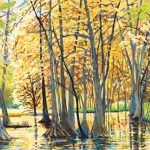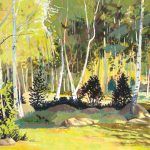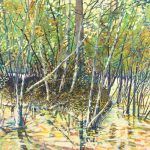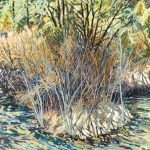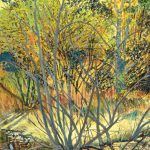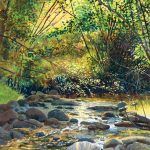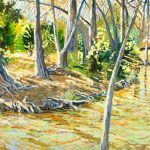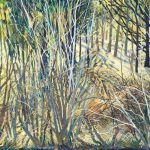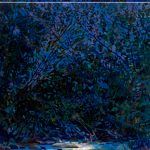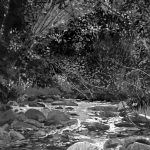Jane K. Starks helps us look closely at the landscape
By Bonnie Gangelhoff
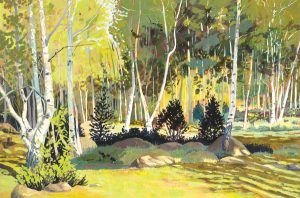
Jane K. Starks, Mytoge Mountain Road, Summer, 2013, gouache/watercolor, 27 x 41.
This story was featured in the August 2016 issue of Southwest Art magazine. Get the Southwest Art August 2016 print issue or digital download now–then subscribe to Southwest Art and never miss another story.
When spring arrives in northern New Mexico, artist Jane K. Starks is often found standing in a flowing stream in her rubber fishing waders. Before her is an easel, and she is capturing in paint the pristine scene that unfolds around her. “I really like painting reflections, transparent surfaces, and the way the surface of the water mirrors all of the reality of vegetation, sky, and rocks surrounding it,” Starks says.
The landscape painter doesn’t have to go far to find her treasured subject matter. From her home in Taos, she is just a few minutes away from Pot Creek, a frequent painting destination. Another favorite setting is also close at hand—forests. Starks lives on the edge of the Carson National Forest. In fact, she is fond of calling her adopted hometown “a day camp for adults” because the area is rich with ideal places to hike, camp, explore, and paint. And there are plenty of like-minded folks who share her interests in art, nature, archeology, and the environment.
Starks works in gouache, an opaque watercolor that dries instantly. “I call gouache ‘the virtuous medium,’” she says. “It forces you to be honest because every stroke is recorded, and you can’t massage it into oblivion.” Gouache [pronounced gwash] also allows Starks to create highly gestural, expressive marks. And a quintessential Starks landscape shimmers with color and light. In fact, there are so many patches of color and marks that a printmaker who observed her work once noted that Andy Warhol had four colors in his artworks while her paintings could contain as many as 48 different colors.
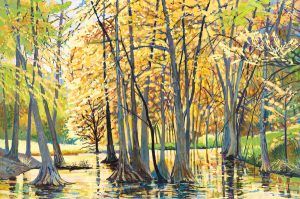
Jane K. Starks, East Fork Frio River, Autumn, 2013, gouache/watercolor, 27 x 41.
Starks’ landscape paintings are created entirely on location and may take up to a week to complete. Over the course of six or seven days, she spends about 20 hours observing, absorbing, and translating a scene from three to two dimensions. “I have a window of three hours a day,” she says. “When I am on location, I feel like there is someone above the scene holding a flashlight that moves over the landscape, and I then capture all the different light situations as that happens.”
Born in 1951 in Long Beach, CA, Starks grew up in nearby Fullerton, where she drew and painted from an early age. After high-school graduation she entered California State University at Long Beach and earned a degree in archeology, which would remain a lifelong passion. Upon graduation from college in 1974, she married, and her husband’s job eventually required the couple to move a number of times. While living in Austin, TX, she entered the graduate program in community and regional planning in the School of Architecture at the University of Texas, completing a master’s degree in 1985. Her focus at the time was on transportation planning for the mentally challenged.
When another move landed the couple in Dallas, where she raised her two children, she volunteered for and then was employed by the Association for Retarded Citizens to help Dallas Area Rapid Transit set up mobility training services for mentally challenged people, teaching them how to ride the bus. “Looking back, it is fair to say that growing up with a severely disabled sibling influenced my decision to volunteer, at different times of my life, with persons with various mental health challenges,” Starks says.
During her time in Texas she also began nurturing her interest in art, taking classes in community education programs in both Austin and Dallas. In 1997, wanting to pursue her interest more seriously, she enrolled in a master’s program at Southern Methodist University in Dallas, graduating two years later. In 2007 she moved to Taos, where there were plenty of public lands and wilderness areas where she could park her portable easel. What better town for an artist than Taos, where early 20th-century artists such as Ernest Blumenschein, Joseph Sharp, and Oscar Berninghaus dedicated their artistic lives to capturing the spirit of the Southwest.
A hundred years later, Starks carries on their devotion to telling the story of the region. Unlike her predecessors, however, her paintings never feature manmade structures, animals, or people. As she puts it, “No roads, deer, bridges, old trucks, or livestock.” For Starks such elements relegate the natural wonders to the background rather than making them the focal point of a landscape work. “I want the viewer to feel as I feel when painting, surrounded by the landscape in all its immediacy without being distracted by other content,” she says.
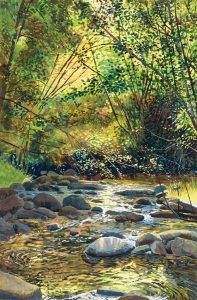
Jane K. Starks, Pot Creek, Late Summer, 2012, gouache/watercolor, 41 x 27.
Ironically, it is often manmade elements like ancient pueblos that first prompt her to explore an area. To this day, Starks has retained a keen interest in archeology; in her spare time, as a member of the Taos Archaeological Society, she has helped map a prehistoric trail system leading out of Ojo Caliente and is currently helping survey archaic sites north of Tres Piedras—both northern New Mexico communities. Starks is an avid student of locales where she paints, including Dinosaur Valley State Park and Blanco Canyon in Texas and the San Rafael Swell and Escalante River canyons in Utah. “Archeology and history are what gets me exploring the landscape, and then they lead me to particular scenes that I want to paint,” she says.
In the painting POT CREEK, LATE SUMMER, 2012, Starks brings together her interest in archeology with her signature painting style. Pot Creek was once the site of a 13th-century pueblo with multistoried blocks of rooms. The painting, created over a number of days between 8:30 and 11:30 a.m., is a light-filled landscape that is alive with vibrant patches of color. The artist explains that the range of values, from very light to very dark, plus the range of hues—blues, greens, reds, oranges, and browns—create an active surface with a lot of depth due to the play of shadows and light.
Starks chooses to beckon viewers up close to this piece by using a vertical format instead of the more conventional horizontal format. This choice, she says, allows her to include extreme foregrounds as well as the sky, which, in this case, is reflected in the water. “The unusually large scale [the piece is over 3 feet high] also means that the viewer is face to face with the image,” Starks says. “And gouache allows me to make marks with clear, sharp edges, which provide a higher degree of contrast that projects forward, as opposed to a rendered surface composed of blended brushwork, which tends to recede.”
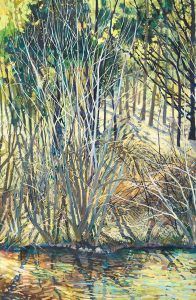
Jane K. Starks, Fort Burgwin, Winter, 2014, gouache/watercolor, 41 x 27.
Starks works a bit counterintuitively: The more intimate the scene, the larger the scale of the work. Thus, landscapes depicting Blanco Canyon and the Sangre de Cristo mountains tend to be small pieces with very grand subject matter. Starks’ large paintings tend to feature intimate views of subjects such as forest interiors that often include multiple planes from foreground to background. “I’m trying to create for the viewer the same sense of absorption and immersion I get from being in, not just looking at, the landscape,” she says. “I am trying to produce for the viewer an experience of intimacy gained by looking a little more closely than they would otherwise.”
For a 2014 show with photographer Debora Hunter, Starks began exploring the use of a computer in her work. Today, she occasionally scans her pieces and then digitally manipulates elements such as color and size to expand her repertoire as an image maker, she says. With the help of an assistant, whom she directs, the image of her original work can change from a day scene to a night scene, for example. She then prints the new image on high-quality photographic paper or canvas. Through computer applications she can transform her palette, experiment with abstraction, and shift from small to large scale while exploring many new techniques. Starks calls the process data-mining. “I am using the reality of my paintings to create a new reality,” she adds.
But no matter what techniques she uses to create her images, Starks’ mission is to contribute to a visual archive of landscapes that have become endangered by constant human activity. “I hope my paintings serve as a record of the solitude and beauty of the diminishing wilderness under our domain,” Starks says.
representation
Valley House Gallery & Sculpture Garden, Dallas, TX.
Featured in the August 2016 issue of Southwest Art magazine. Get the Southwest Art August 2016 print issue or digital download now–then subscribe to Southwest Art and never miss another story.
- Jane K. Starks, East Fork Frio River, Autumn, 2013, gouache/watercolor, 27 x 41.
- Jane K. Starks, Mytoge Mountain Road, Summer, 2013, gouache/watercolor, 27 x 41.
- Jane K. Starks, Pot Creek, Late Spring, 2015, gouache/watercolor, 27 x 41, collection of BNSF Railway.
- Jane K. Starks, Pot Creek, Winter, 2015, gouache/watercolor, 27 x 41.
- Jane K. Starks, Pot Creek, Fall, 2012, gouache/watercolor, 41 x 27.
- Jane K. Starks, Pot Creek, Late Summer, 2012, gouache/watercolor, 41 x 27.
- Jane K. Starks, East Frio River, Winter, 2016, gouache/watercolor, 27 x 41.
- Jane K. Starks, Fort Burgwin, Winter, 2014, gouache/watercolor, 41 x 27.
- Jane K. Starks, Pot Creek Late Summer Nocturne, diptych, acrylic, 53 x 27.
- Jane K. Starks, Pot Creek, Late Summer, 2012, Nocturne, archival ink on photography paper, 41 x 27.
MORE RESOURCES FOR ART COLLECTORS & ENTHUSIASTS
• Subscribe to Southwest Art magazine
• Learn how to paint & how to draw with downloads, books, videos & more from North Light Shop
• Sign up for your Southwest Art email newsletter & download a FREE ebook






